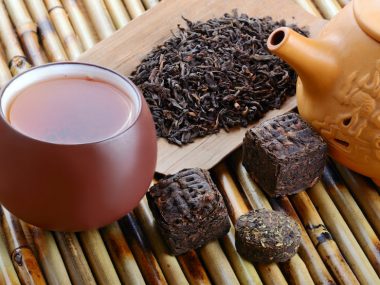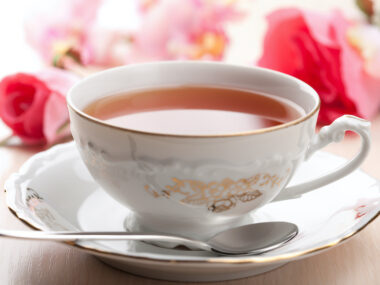We have a tea that transforms an empty teacup into a dance of tea leaves unfurling. As you gaze and watch this odd unfolding of beauty, your senses are quickly drawn into the mesmerizing aroma and taste of a very complex Oolong tea.
Table of Contents
What Is Tieguanyin Tea?
“Tieguanyin” is a variety (group of plants that come from the tea plant Camellia sinensis.) Tea made from the Tieguanyin variety is a semi-fermented Oolong, and it is a very complex tea that is often misunderstood. To better understand its complexities, let’s take a closer look at this tea.
Two countries produce this tea; Taiwan and China. Both have their own unique style of making the tea. A cup of Chinese Tieguanyin will look and taste different compared to a cup of Taiwanese Tieguanyin.
History Of Tieguanyin Tea
Tieguanyin is said to have been revealed to a Chinese man in his dreams. A Chinese goddess (Guan Yin) spoke to him, telling him where to find this special tea plant. He went to the place the goddess told him about where he discovered a Tieguanyin tea plant.
To honor the Goddess Guan Yin, he named the tea plant “Tie (which means “iron”) – Guan Yin.” The tea leaves’ dark brownish-green color resembled the color of iron which is why he incorporated “Tie” (iron) into the name of the tea plant.
There are claims that Emperor Qian Long brought Tieguanyin tea (traditionally processed) to the forefront of the tea industry in the 1700s. During the early 1900s, this tea plant made its way into Taiwan, where it began to be cultivated heavily in the Muzha area.
Today, you will find the mother tea plant tree in the ruins of a temple in Xiping, China. It is poised on the side of a hill just below a walkway where it flourishes. Not too much further above the hill sits several other tea plant trees that are said to be the children of the mother tree.
Taiwan Tieguanyin Vs. Chinese Tieguanyin Tea
Ironically, Tieguanyin is grown in the Anxi region of Taiwan and in Anxi (Fujian Province) of China. Why and how “Anxi” is intertwined in two separate areas in two different countries is a mystery in and of itself.
The processing methods of this tea are different; Taiwan uses the traditional method, whereas China uses the more modern processing method. The Taiwanese version of Tieguanyin is a dark Oolong that is heavily roasted, whereas the Chinese version is a lighter (greenish) Oolong that is lightly roasted or not roasted at all.
In Taiwan, This tea is sold according to the elevation it’s grown at; low, medium, or high. Each elevation produces a tea with its own unique taste and qualities. In China, Tieguanyin isn’t sold in elevation variations.
Regardless of origin, you will often find that Tieguanyin is sold under many different names. When purchasing Tieguanyin tea, it’s important to look at the origin. The origin depicts whether the tea will be roasted or unroasted, traditionally or modern processing, fermentation, and taste.
China Origin
- Iron Goddess
- Iron Buddha
- Ti Kuan Yin
- Tiet Kwun Yum
- Goddess of Mercy
- Monkey-Picked Tieguanyin
- Anxi Tieguanyin
- Prince of Peace
Taiwan Origin
- Iron Goddess
- Muzha Tieguanyin
- High Mountain
- Rishi Iron Goddess of Mercy
Beware Of Counterfeit Tieguanyin Tea
Before we move on to explain how this tea is processed, it’s important to know that many tea marketers in the tea industry dishonestly sell a Tieguanyin tea grown, harvested, and processed in areas other than Anxi (China.) Anxi, Fujian Province of China Tieguanyin tea is considered the premium Tieguanyin. Unfortunately, it’s quite easy to buy this tea, assuming you are getting the best when it has been illegally passed off as a low-quality tea from an ambiguous origin.
The best way to know if you are getting the “real deal” is to look at identification labels. A true Anxi Chinese Tieguanyin tea will be identified as “Protected Geographical Indication” (PGI.) China and Europe have partnered in using a PGI logo on products (which includes Tieguanyin tea) to indicate a protected, high-quality product. If you find a PGI logo tea packaging and it is not an exact match, the tea is most likely a counterfeit.
Processing Methods Of Tieguanyin
There are two processing methods for Tieguanyin tea; traditional and modern. The traditional method is known as “Chuan Tong,” The modern method is known as “Qing Xiang.”
In Taiwan, Tieguanyin is typically processed the traditional way. Post-processing includes roasting (medium to heavy roasts.) China, on the other hand, prefers the modern processing method with post-processing of light roasting (or no roasting at all.)
Traditional Method
Tea leaf pickers pick 3-4 leaves (no buds.) The harvested tea leaves are then taken to the processing house, where they are laid out in the sun on bamboo trays to wither. During this withering, the leaves are continually moved by workers with gentle tossing.
Next, the tea leaves are moved indoors, where the bamboo trays full of leaves are placed on racks. They remain on these racks for a certain amount of time (hours to days), where they are further withered (oxidized.) During this indoor withering, the workers occasionally move the tea leaves around on the bamboo trays to allow ample air exposure.
After withering is completed, the tea leaves undergo fixation, which is applying heat to stop the oxidation process. Heating is typically done in a barrel-like oven. After the right amount of heat has been applied to the tea leaves, they are removed from the oven and allowed to cool down, or they may go on to rolling/shaping. Each tea producer has a unique methodical manner in processing tea at this point.
Generally, when the tea is either removed from the oven or has cooled, the next step is placing them into a tied cloth to form a ball. The cloth is secured to a stick which the worker twists. This twisting motion tightens the cloth ball while compacting the tea leaves.
The compacted ball of tea leaves is moved in all different manners (and may even be stomped on by foot.) This causes the tea leaves to curl and ball up into Tieguanyin’s characteristic ball shape.
After rolling and shaping are done, the worker releases the curled-up tea leaves from the cloth. The curled-up leaves go on to be roasted over charcoal fires. The tea leaves are placed in a bamboo tray that goes directly over a 2-3’ chimney. During roasting, workers toss the tea leaves about to help them roast evenly. After roasting, the tea goes on to packaging and off to market.
Modern Method
China uses technology and innovation when it comes to processing Tieguanyin. Rather than doing most of the processing by hand, it is done by machines. Harvesters still pluck the tea leaves by hand; however, the rolling, shaping and drying are all done in very large machines.
What sets Chinese Tieguanyin apart from its Taiwan counterpart is the use of machinery and either employing a very light roast or no roast at all.
What Does Tieguanyin Tea Taste Like?
The Taiwanese Tieguanyin’s tea leaves are very dark, and when brewed, the soup is a dark copper color. The aroma is reminiscent of a roasty, peachy fragrance (if there were such a thing.) When tasting this tea for the first time, a tea drinker immediately takes notice of its intense flavors that are nutty and fruity enrobed in a refined smokiness.
Brewed Tieguanyin Chinese tea is a jade green that produces a soup that is more yellowish-amber. Before sipping the tea, the beautiful orchid aroma captures the senses. The first sip of this tea quietly speaks to the palate with a light, brightness of utter sweetness.
Is Tieguanyin High In Caffeine?
According to Megan Metropulos (Registered Dietician Nurse), an eight-ounce cup of Tieguanyin tea can yield anywhere from 10 to 60 mg of caffeine. This Oolong tea has comparable caffeine levels as green tea does.
The FDA (U.S. Food and Drug Administration) warns against consuming more than 400 mg of caffeine per day. With this in mind, you can safely enjoy about 4-6 cups of Tieguanyin tea each day.

Tieguanyin Tea Benefits
There are numerous advantages to drinking this Oolong tea. Tieguanyin benefits mainly come from constituents found in tea that includes catechins. The British Journal Of Nutrition mentions that those who consume ten ounces of Oolong tea each week were found to have decreased levels of bad cholesterol (LDL.)
In another published study (“Beneficial Effects Of Oolong Tea Consumption On Diet-induced Overweight And Obese Subjects”), researchers found that half of the Chinese test subjects (with weight issues) who consumed Oolong tea four times a day had achieved weight loss after six weeks. Additionally, by consuming three (or more) cups of Oolong tea a day, those with Type II Diabetes experienced fewer problems.
The Europe PubMed Central lists Oolong tea as having antioxidant and anti-inflammatory benefits. Furthermore, The Royal Society of Chemistry mentions Oolong tea as boosting the health of the cardiovascular system because of catechin derivatives.
Is It Okay To Drink Tieguanyin Tea Every Day?
As we tell all prospective tea drinkers, talk to your doctor before drinking any tea or tisane. Sometimes medical conditions, medications, or treatments may be provoked, worsened, or interact with tea.
Tieguanyin tea may cause side effects, as reported by the National Cancer Institute’s Tea Fact Sheet. Some of these side effects can include digestive issues, headaches, feeling dizzy, or muscle aches and pains.
How Do You Make Tieguanyin Tea?
Tieguanyin brewing is relatively straightforward. This tea can be enjoyed hot or iced in the summer.
Ingredients
- 1 teaspoon of Tieguanyin loose-leaf tea
- 1-1 ½ cups of water
- 1 medium piece of beet sugar
Directions
- Heat the water to about 194-205 degrees (F) (90-95 degrees C.)
- Remove from the heat.
- Place the loose-leaf tea into an infuser.
- Pour the hot water into a teapot.
- Drop the tea infuser into the teapot.
- Add the beet sugar to the hot water in the teapot.
- Cover and allow it to steep for 3-5 minutes.
- Remove the cover.
- Pour the tea into a teacup and enjoy!
Another MUST-Try Tea
If you take the time to source a reputable Tieguanyin tea with the PGI logo and place of origin of the tea, you will come to love this tea. Even the worst of days become brighter and less clouded with the “blahs” with a cup of Tieguanyin tea.






